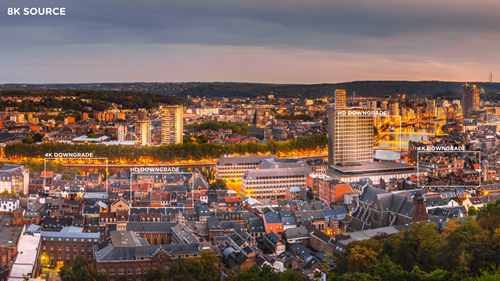8K in figures
The term 8K stands for resolutions with a width of around 8000 pixels.
In the video and broadcast industry, it translates to the UHDTV-2 format based on a 7680x4320 resolution which is four times more detailed than UHDTV-1 (3840x2160) and sixteen times denser than HD (1920x1080).
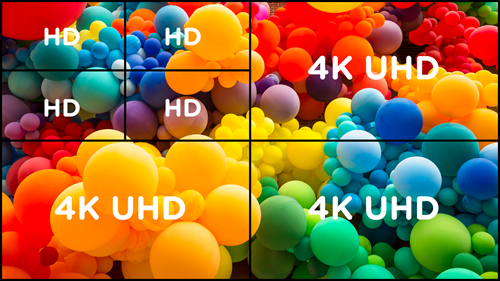
In the Digital Cinema domain, the 8K DCI resolution is 8192x4320, which is 4x 4K DCI (4096x2160) and 16x 2K DCI (2048x1080).
One 8K picture represents a massive amount of pixels. Around 33 million of them, actually.
While the gain in details is noticeable when compared to 4K resolutions, it looks revolutionary when compared to HD, as illustrated below.
CLICK ON THIS PICTURE and display it at a 100% scaling factor. Pan to the 4K and HD zones to see details loss!
The 8K technology is intended to large format displays, although also supported by some high-end smartphones. 8K resolution is often associated with high frame rate (60fps and above) and with High Dynamic Range (HDR) colorimetry, to offer an unprecedented viewer experience.
At 60 frames per second, an 8K feed represents around 2 billion of pixels per second. Such a pixel rate brings in new challenges in terms of capture, transport, storage, processing and display!
As video interfacing is the core business of DELTACAST, let’s focus more on the transport aspects.
8K transport in SDI
SDI interfacing norms evolved over the years to reach the incredible throughput of 12Gbps, which is the capacity required by a 4K feed.
8K transport in SDI requires teaming four 12G-SDI link to create a 48Gbps virtual interface.
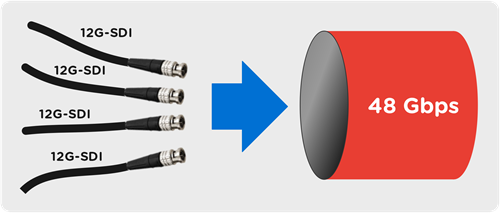
Early days 8K experiments and productions based on SDI transport used the proven “quadrants” technique previously widely used to convey 4K feed over four 3G-SDI links.
This time, the 8K picture is split in four 4K divisions, on each one carried on through a dedicated 12G-SDI. Not being standard, this technique requires the four link to be perfectly synchronized, and properly identified to not mix up the quadrants during 8K picture reconstruction.
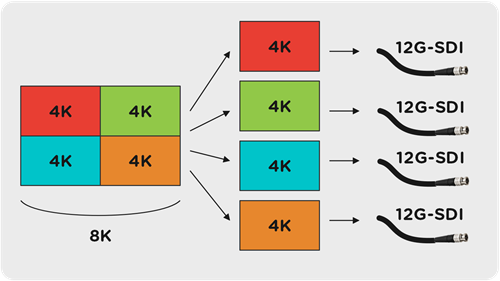
Then, the SMPTE consortium published the ST 2082-12 standard for 4320-line and 2160-line source image and ancillary data mapping for quad-link 12G-SDI. This norm defines the quad-link transport method also known as “2SI” for two-sample interleaving.
In this method, the 8K picture is divided into four 4K sub-images in accordance with the 2 sample interleave subdivision illustrated below. Then, each 4K sub-image is divided again into four 1080p sub-image accordingly to a similar method (ruled by SMPTE ST 2081-10), resulting in eight data streams to be muxed together into the 12G-SDI container.
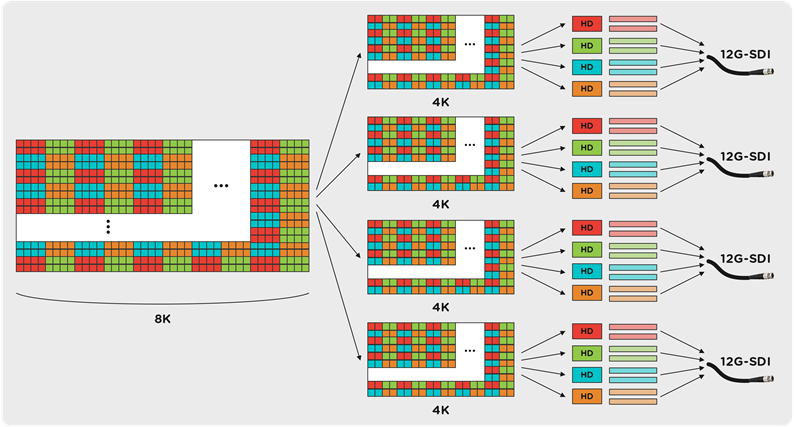
One of the advantages of the 2SI method is that each 4K subdivision contains a downscaled version of the initial picture and, eventually, each of the four sub-images of each subdivision also contain a HD version of the initial 8K feed.
Other 8K interfaces
Latest generation of consumer interfaces like HDMI and DisplayPort also allow 8K transport.
HDMI 2.1, with its 48Gbps bandwidth, support 8K transport at up to 50 frames per second in 4:4:4 RGB or YUV. To reach higher format or frame rate, HDMI 2.1 uses a 3:1 ratio mezzanine compression named DSC (Display Stream Compression).
DisplayPort 1.4 also combine the DSC compression with the HBR3 transmission mode at 32.4Gbps to support 8K transport at up to 60fps. The new DisplayPort 2.0 standard triple the available bandwidth, and allows 8K60 HDR uncompressed transport.
DELTACAST 8K products
Addressing 8K transport in SDI requires at least four 12G-SDI channels. The current DELTACAST products allow 8K transport, either in quadrant split or in two-sample interleaving:
- The DELTA-12G-elp-h 40 hosts 8 input channels, with four of them being 12G-SDI capable. The card hence supports capture of one 8K feed
- The DELTA-12G-elp-h 04 hosts 8 output channels, with four of them being 12G-SDI capable. The card hence supports emission of one 8K feed
- The DELTA-12G-elp-h 4c hosts 8 channels, with four of them being 12G-SDI capable. Each channel can be configured as an input or an output, so this product can either capture or emit one 8K feed

